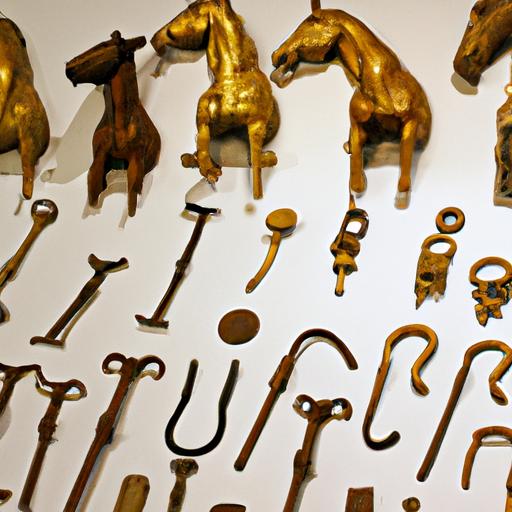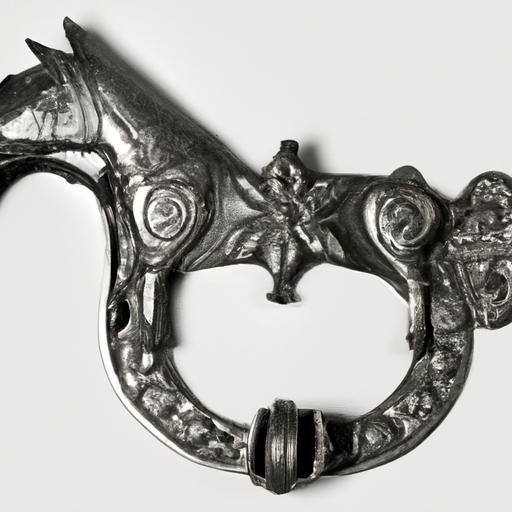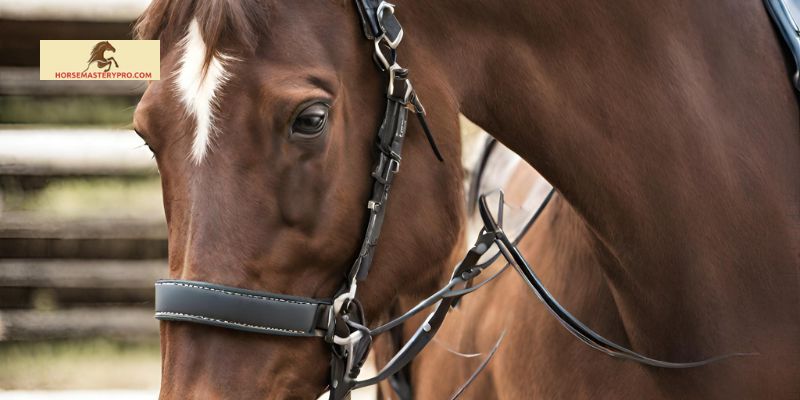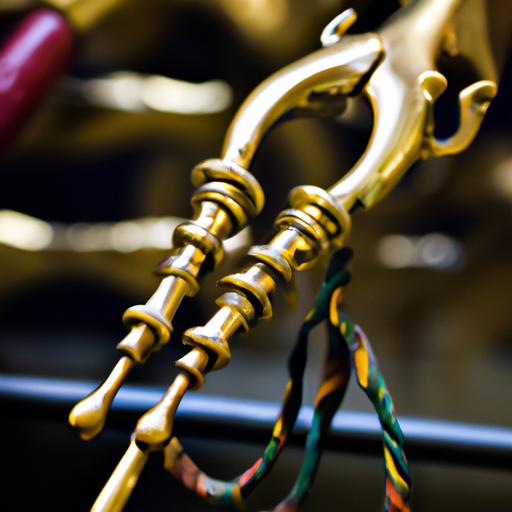Uncover the fascinating tale of horse bit history as we journey through time, exploring the evolution and significance of these essential equestrian tools.
Picture this: the majestic beauty of a horse, its powerful muscles rippling beneath its sleek coat. Now, imagine the delicate instrument that allows us to communicate with this magnificent creature – the horse bit. Throughout history, horse bits have played a crucial role in equestrian activities, enabling riders to establish control and guide their noble steeds. Today, we embark on a captivating journey into the past as we explore the intriguing world of horse bit history.
A Glimpse into the Equine Connection

Before we delve into the annals of time, let’s take a moment to appreciate the significance of horse bits in horse riding. These small, yet pivotal, pieces of equipment serve as a vital link between rider and horse, facilitating communication and providing cues for direction, speed, and posture. The right bit can enhance the harmony between horse and rider, creating a seamless and effortless partnership.
Unraveling the Enigma: Horse Bit History

Now, let’s turn our attention to the main focus of our journey – the captivating history of horse bits. As we traverse the corridors of time, we encounter ancient civilizations that left indelible imprints on the evolution of horse bits. From the mesmerizing lands of Mesopotamia to the enigmatic realm of Egypt, these ancient cultures were the birthplace of early evidence of horse bits. Crafted from materials like bronze and iron, these primitive bits were functional, albeit rudimentary, in design.
The medieval period witnessed a remarkable transformation in horse bit designs. Various cultures, such as the Europeans and Arabians, infused their unique influences into the development of these essential tools. Horse bits became integral to medieval equestrian activities, including warfare and hunting, as they provided riders with greater control and maneuverability. The intricate craftsmanship and diversity of these bits reflected the rich tapestry of equestrian traditions during this era.
As the Renaissance dawned, horse bits underwent a renaissance of their own. Technological advancements and the introduction of new materials revolutionized the manufacturing process, leading to innovative designs that prioritized both horse comfort and rider control. These developments paved the way for the modernization of horse bits, setting the stage for contemporary equestrian practices.
Intrigued? Join me as we continue our journey through the evolution of horse bits. In the next section, we delve deeper into the ancient origins of horse bits, unearthing fascinating insights into their designs and functionalities. Stay tuned for a captivating exploration of the equine world’s hidden treasures!
Ancient Origins of Horse Bits
Unearthing the Past: Early Evidence of Horse Bits
In the ancient realms of Mesopotamia and Egypt, evidence of horse bits emerges from the depths of history, painting a vivid picture of their significance in early civilizations. These ancient cultures recognized the need for a tool to control and guide their equine companions, and thus, the concept of the horse bit was born. From ancient artifacts and murals, we catch glimpses of the earliest forms of horse bits, revealing the ingenuity of our equestrian ancestors.
Materials that Shaped History
Bronze and iron – these were the materials that forged the earliest horse bits. Craftsmen of the past utilized their skills to transform these metals into functional tools that would enable riders to communicate with their horses effectively. The durability and malleability of bronze and iron allowed for the creation of intricate designs that could withstand the rigors of horse riding.
A Symphony of Form and Function
The early horse bits were not merely utilitarian objects; they encompassed an artful blend of form and function. The design of these ancient bits was driven by the need to exert control over the horse while ensuring its comfort. From simple snaffles to more complex curb bits, the functionality of these early designs laid the foundation for the evolution of horse bits throughout history. As riders discovered the delicate balance between pressure and release, they unlocked the secrets of effective communication with their equine partners.
As we continue our journey through the annals of horse bit history, we encounter the medieval period, a time of great innovation and cultural influence. Join me in the next section as we explore the evolution of horse bits during this captivating era, where the equestrian world was forever changed. From the battlefields to the hunting grounds, the medieval horse bit played a pivotal role in shaping the bond between rider and horse. Let’s uncover the secrets of this remarkable period together!
Evolution of Horse Bits in Medieval Times

The medieval period marked a significant turning point in the evolution of horse bits. With the rise of chivalry and the prominence of equestrian activities, horse bits became more sophisticated and varied in design. Let’s delve into this captivating era and explore the fascinating developments that emerged.
Introduction of Different Types of Horse Bits
During the medieval period, a plethora of horse bit variations emerged, each with its unique characteristics and purposes. The straight bar bit, the simplest of them all, provided basic control and encouraged a direct response from the horse. The double-jointed snaffle bit, on the other hand, offered more subtlety and allowed for lateral flexion, enabling finer communication between horse and rider. These were just a few examples of the diverse range of horse bits that emerged during this time.
Influence of Different Cultures on Horse Bit Designs
The medieval era was a melting pot of different cultures, and their influences were evident in horse bit designs. European cultures introduced elaborate and intricately designed bits, adorned with decorative elements that reflected the ornate aesthetics of the time. Arabians, renowned for their horsemanship, contributed their expertise, leading to the development of innovative bits that emphasized sensitivity and responsiveness.
Role of Horse Bits in Various Equestrian Activities
Horse bits played an indispensable role in various equestrian activities during the medieval period. In times of warfare, bits provided riders with the necessary control and maneuverability to navigate the chaos of the battlefield. They allowed knights to guide their steeds through charges and turns with precision and finesse. Additionally, in the realm of hunting, specialized bits facilitated communication between horse and rider, enabling them to work together seamlessly in pursuit of game.
As we immerse ourselves in the medieval era, we begin to grasp the significance of horse bits in shaping the equestrian landscape of the time. Join me in the next section as we uncover the Renaissance and the modern innovations that revolutionized horse bit designs, taking them to new heights of functionality and comfort. Prepare to be enthralled by the ingenuity that emerged during this transformative period!
Renaissance and Modern Innovations in Horse Bit Designs
Transitioning from Medieval to Renaissance Horse Bit Designs
As the Renaissance period ushered in a wave of cultural and intellectual revolution, horse bit designs experienced a fascinating transition. The medieval bits, characterized by their practicality and functionality, began to evolve into more aesthetically pleasing and intricate designs. The Renaissance saw a departure from the purely utilitarian approach, with artisans and craftsmen infusing artistry and elegance into their creations.
Technological Advancements and New Materials in Horse Bit Manufacturing
During the Renaissance, technological advancements and the exploration of new materials revolutionized the manufacturing process of horse bits. The introduction of iron casting techniques allowed for more intricate and precise designs. Additionally, the exploration and utilization of various metals, such as stainless steel and copper alloys, offered enhanced durability and corrosion resistance. These advancements not only improved the longevity of horse bits but also allowed for greater customization and versatility.
Impact of Horse Bit Designs on Horse Comfort and Rider Control
The evolution of horse bit designs during the Renaissance and beyond had a profound impact on both horse comfort and rider control. The intricate designs, incorporating features such as jointed mouthpieces and ergonomic shapes, aimed to minimize discomfort and pressure on the horse’s mouth. By providing a more comfortable experience, these innovative designs fostered trust and cooperation between horse and rider.
Furthermore, the refined and balanced construction of modern horse bits enhances rider control, facilitating nuanced communication between horse and rider. This improved control allows riders to guide their horses with subtle signals, promoting harmony and precision in their movements.
In the next section, we will venture into the realm of contemporary equestrian practices, exploring the commonly used horse bits in various disciplines. Join me as we unravel the present-day applications of these age-old tools and discover how they continue to shape the equestrian world.
Horse Bits in Contemporary Equestrian Practices
As we journey into the modern era of equestrianism, it is essential to understand the role of horse bits in today’s equestrian disciplines. Let’s delve into the commonly used horse bits and explore the significance of proper bit fitting and selection for achieving harmony between horse and rider. Additionally, we will uncover the emerging trends and innovations in horse bit designs that are shaping the future of equestrian sports.
A Glimpse into Modern Equestrian Disciplines
In the vast realm of equestrian sports, various disciplines have emerged, each with its own set of specialized horse bits. Whether it’s the elegant artistry of dressage, the adrenaline-fueled world of show jumping, or the thrilling challenges of eventing, selecting the right bit is vital for optimal performance and communication. An overview of the commonly used horse bits in these disciplines will provide valuable insights into the diverse options available to riders.
Bit Fitting: Where Harmony Begins
The importance of proper bit fitting cannot be overstated. Just as we strive for the perfect fit in our own attire, horses deserve the same consideration. A well-fitted bit ensures comfort, minimizes discomfort, and maximizes communication. It is crucial to consider factors such as the horse’s conformation, mouth shape, and sensitivity when selecting a bit. By finding the right fit, we lay the foundation for a harmonious partnership between horse and rider.
Embracing Innovation: Trends in Horse Bit Designs
In the ever-evolving world of equestrianism, innovation plays a key role in shaping horse bit designs. Riding enthusiasts, trainers, and manufacturers are continually exploring new materials, advanced technologies, and cutting-edge designs to enhance horse welfare and rider control. From ergonomic mouthpieces to bitless options, the equestrian community is witnessing exciting breakthroughs that challenge traditional notions of horse bit usage. These emerging trends and innovations not only prioritize the well-being of our equine partners but also open doors to new possibilities in equestrian sports.
As we conclude our exploration of contemporary equestrian practices, it becomes evident that horse bits are not mere tools but intricate components of a dynamic partnership between horse and rider. In the next section, we will wrap up our journey with a reflection on the rich history of horse bits and their enduring significance in the equestrian world. Join me for a captivating conclusion as we bid farewell to the secrets of horse bit history!


